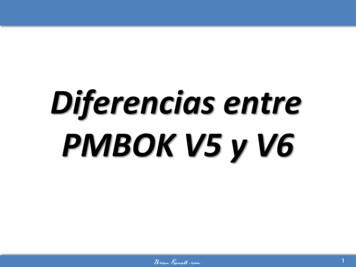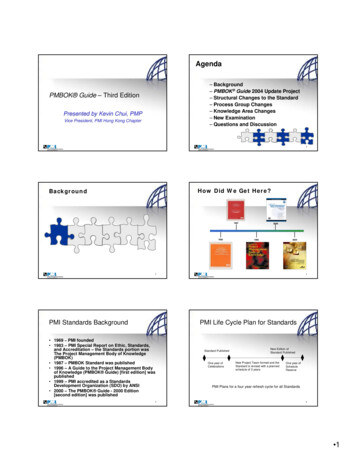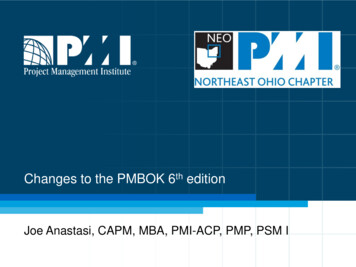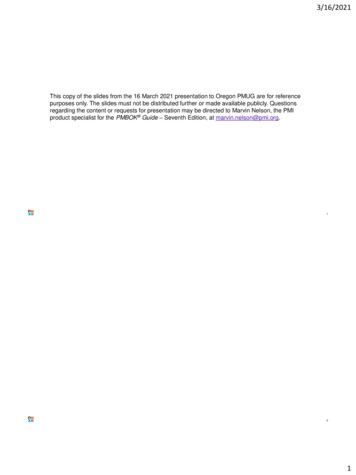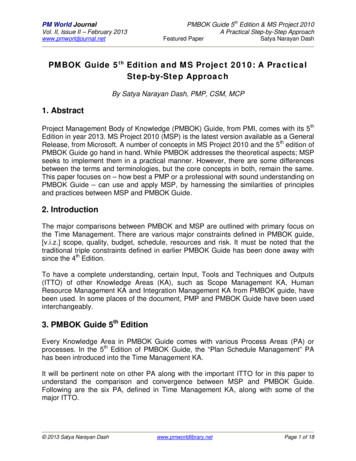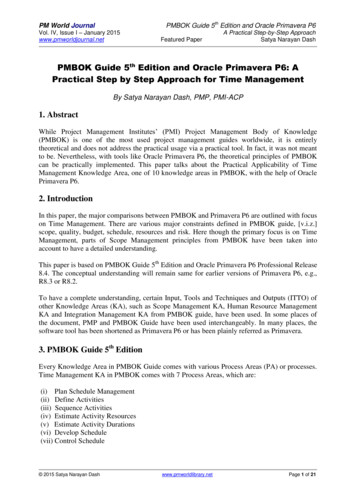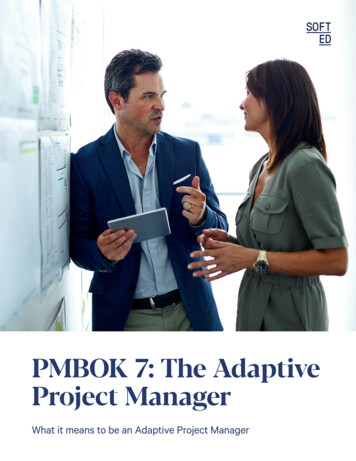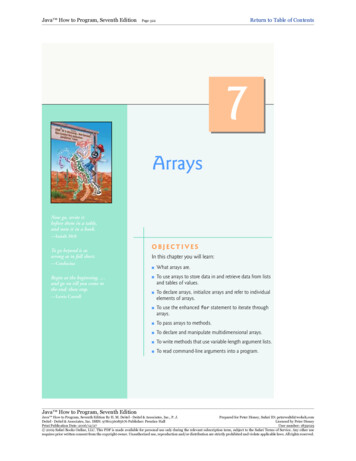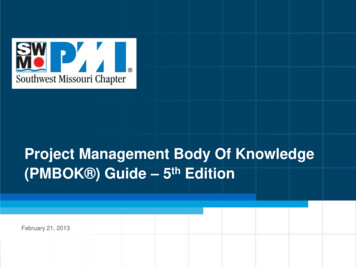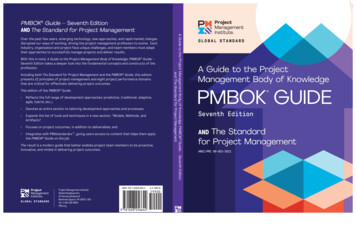
Transcription
PMBOK Guide – Seventh EditionAND The Standard for Project ManagementWith this in mind, A Guide to the Project Management Body of Knowledge (PMBOK Guide) –Seventh Edition takes a deeper look into the fundamental concepts and constructs of theprofession.Including both The Standard for Project Management and the PMBOK Guide, this editionpresents 12 principles of project management and eight project performance domainsthat are critical for effectively delivering project outcomes.This edition of the PMBOK Guide: Reflects the full range of development approaches (predictive, traditional, adaptive,agile, hybrid, etc.); Devotes an entire section to tailoring development approaches and processes; Expands the list of tools and techniques in a new section, “Models, Methods, andArtifacts”; Focuses on project outcomes, in addition to deliverables; and Integrates with PMIstandards , giving users access to content that helps them applythe PMBOK Guide on the job.The result is a modern guide that better enables project team members to be proactive,innovative, and nimble in delivering project outcomes.A Guide to the Project Management Body of Knowledge (PMBOK Guide) – Seventh Editionand The Standard for Project ManagementOver the past few years, emerging technology, new approaches, and rapid market changesdisrupted our ways of working, driving the project management profession to evolve. Eachindustry, organization and project face unique challenges, and team members must adapttheir approaches to successfully manage projects and deliver results.GLOBAL STANDARDA Guide to the ProjectManagement Body of KnowledgePMBOK GUIDE Seventh EditionThe Standardfor Project ManagementANDANSI/PMI 99-001-2021Project Management InstituteGlobal Headquarters14 Campus BoulevardNewtown Square, PA 19073 USATel: 1 610 356 4600PMI.orgPMI Member benefit licensed to: Omid Shirvani - 6704077. Not for distribution, sale, or reproduction.PMBOK Guide 7thED cover spread.indd 15/3/21 4:57 PM
THE STANDARD FORPROJECT MANAGEMENTandA GUIDE TO THE PROJECTMANAGEMENT BODYOF KNOWLEDGE(PMBOK GUIDE)Seventh EditionPMI Member benefit licensed to: Omid Shirvani - 6704077. Not for distribution, sale, or reproduction.
Library of Congress Cataloging-in-Publication DataNames: Project Management Institute, publisher.Title: The standard for project management and a guide to the project management bodyof knowledge (PMBOK guide).Other titles: Guide to the project management body of knowledge (PMBOK guide) PMBOK guideDescription: Seventh edition. Newtown Square, Pennsylvania: Project Management Institute, Inc.,[2021] Includes bibliographical references and index. Summary: "Over the past few years, emergingtechnology, new approaches, and rapid market changes disrupted our ways of working, drivingthe project management profession to evolve. Each industry, organization and project face uniquechallenges, and team members must adapt their approaches to successfully manage projects anddeliver results. With this in mind, A Guide to the Project Management Body of Knowledge (PMBOK Guide) - Seventh Edition takes a deeper look into the fundamental concepts and constructs of theprofession. Including both The Standard for Project Management and the PMBOK Guide, this editionpresents 12 principles of project management and eight project performance domains that are criticalfor effectively delivering project outcomes. This edition of the PMBOK Guide: Reflects the full range ofdevelopment approaches (predictive, traditional, adaptive, agile, hybrid, etc.); Devotes an entire sectionto tailoring development approaches and processes; Expands the list of tools and techniques in a newsection, "Models, Methods, and Artifacts"; Focuses on project outcomes, in addition to deliverables; andIntegrates with PMIstandards , giving users access to content that helps them apply the PMBOK Guideon the job. The result is a modern guide that betters enables project team members to be proactive,innovative, and nimble in delivering project outcomes." – Provided by publisher.Identifiers: LCCN 2021011107 (print) LCCN 2021011108 (ebook) ISBN 9781628256642 (paperback) ISBN 9781628256659 (epub) ISBN 9781628256666 (kindle edition) ISBN 9781628256673 (pdf)Subjects: LCSH: Project management–StandardsClassification: LCC HD69.P75 G845 2021 (print) LCC HD69.P75 (ebook) DDC 658.4/04–dc23LC record available at https://lccn.loc.gov/2021011107LC ebook record available at https://lccn.loc.gov/2021011108PMI Member benefit licensed to: Omid Shirvani - 6704077. Not for distribution, sale, or reproduction.
A Guide to the Project Management Body of Knowledge (PMBOK Guide) -- Seventh Editionand The Standard for Project ManagementISBN: 978-1-62825-664-2Published by:Project Management Institute, Inc.14 Campus BoulevardNewtown Square, Pennsylvania 19073-3299 USAPhone: 1 610 356 4600Email: customercare@pmi.orgInternet: www.PMI.org 2021 Project Management Institute, Inc. All rights reserved.Our copyright content is protected by U.S. intellectual property law that is recognized by mostcountries. To republish or reproduce our content, you must obtain our permission. Please go tohttp://www.pmi.org/permissions for details.PMI, the PMI logo, PMBOK, OPM3, PMP, CAPM, PgMP, PfMP, PMI-RMP, PMI-SP, PMI-ACP, PMI-PBA,PROJECT MANAGEMENT JOURNAL, PM NETWORK, PMI TODAY, PULSE OF THE PROFESSION andthe slogan MAKING PROJECT MANAGEMENT INDISPENSABLE FOR BUSINESS RESULTS. are all marksof Project Management Institute, Inc. For a comprehensive list of PMI trademarks, contact the PMILegal Department. All other trademarks, service marks, trade names, trade dress, product namesand logos appearing herein are the property of their respective owners. Any rights not expresslygranted herein are reserved.To place an order or for pricing information, please contact Independent Publishers Group:Independent Publishers GroupOrder Department814 North Franklin StreetChicago, IL 60610 USAPhone: 800 888 4741Fax: 1 312 337 5985Email: orders@ipgbook.com (For orders only)Printed in the United States of America. No part of this work may be reproduced or transmittedin any form or by any means, electronic, manual, photocopying, recording, or by any informationstorage and retrieval system, without prior written permission of the publisher.The paper used in this book complies with the Permanent Paper Standard issued by the NationalInformation Standards Organization (Z39.48—1984).10 9 8 7 6 5 4 3 2 1PMI Member benefit licensed to: Omid Shirvani - 6704077. Not for distribution, sale, or reproduction.
PMI Member benefit licensed to: Omid Shirvani - 6704077. Not for distribution, sale, or reproduction.
NoticeThe Project Management Institute, Inc. (PMI) standards and guideline publications, of whichthe document contained herein is one, are developed through a voluntary consensus standardsdevelopment process. This process brings together volunteers and/or seeks out the views of personswho have an interest in the topic covered by this publication. While PMI administers the processand establishes rules to promote fairness in the development of consensus, it does not write thedocument and it does not independently test, evaluate, or verify the accuracy or completeness of anyinformation or the soundness of any judgments contained in its standards and guideline publications.PMI disclaims liability for any personal injury, property or other damages of any naturewhatsoever, whether special, indirect, consequential or compensatory, directly or indirectly resultingfrom the publication, use of application, or reliance on this document. PMI disclaims and makes noguaranty or warranty, expressed or implied, as to the accuracy or completeness of any informationpublished herein, and disclaims and makes no warranty that the information in this document willfulfill any of your particular purposes or needs. PMI does not undertake to guarantee the performanceof any individual manufacturer or seller’s products or services by virtue of this standard or guide.In publishing and making this document available, PMI is not undertaking to render professionalor other services for or on behalf of any person or entity, nor is PMI undertaking to perform anyduty owed by any person or entity to someone else. Anyone using this document should rely on hisor her own independent judgment or, as appropriate, seek the advice of a competent professionalin determining the exercise of reasonable care in any given circum stances. Information and otherstandards on the topic covered by this publication may be available from other sources, which theuser may wish to consult for additional views or information not covered by this publication.PMI has no power, nor does it undertake to police or enforce compliance with the contents ofthis document. PMI does not certify, test, or inspect products, designs, or installa tions for safety orhealth purposes. Any certification or other statement of compliance with any health or safety-relatedinformation in this document shall not be attributable to PMI and is solely the responsibility of thecertifier or maker of the statement.PMI Member benefit licensed to: Omid Shirvani - 6704077. Not for distribution, sale, or reproduction.v
PMI Member benefit licensed to: Omid Shirvani - 6704077. Not for distribution, sale, or reproduction.
PrefaceEach time work begins on a new edition of The Standard for Project Management and thePMBOK Guide, there is an opportunity to consider global perspectives on changes in projectmanagement and the approaches used for realizing benefits and value from project outputs. Inthe time between every edition, a world of change has occurred. Some organizations have ceasedto exist, and new organizations have emerged. Older technologies have reached end of life whiletechnologies offering completely new capabilities have evolved. People who continue in theworkforce have advanced their thinking, skills, and capabilities as new entrants focus on quicklyunderstanding their professional language, building their skills, developing their business acumen,and contributing to the objectives of their employers.Even in the midst of such changes, though, there are fundamental concepts and constructsthat remain in place. The understanding that collective thinking produces more holistic solutionsthan the thoughts of one individual continues. And the fact that organizations use projects asa vehicle for delivering a unique result or output endures.CU STOME R- AN D E N D -US E R - C E N T E R E D DE S I G NWhile the Sixth Edition of the PMBOK Guide was under development and throughout developmentof this Seventh Edition, PMI has actively engaged with a broad range of global stakeholders on theirexperiences with using The Standard for Project Management and the PMBOK Guide. These engagementshave included: Online surveys to representative samples of PMI stakeholders; Focus groups with PMO leaders, project managers, agile practitioners, project teammembers, and educators and trainers; and Interactive workshops with practitioners at various PMI events around the globe.PMI Member benefit licensed to: Omid Shirvani - 6704077. Not for distribution, sale, or reproduction.vii
The feedback and inputs collectively emphasized four key points: Maintain and enhance the credibility and relevance of the PMBOK Guide. Improve the readability and usefulness of the PMBOK Guide while avoiding overstuffingit with new content. Sense stakeholder information and content needs and provide vetted supplementalcontent supporting practical application. Recognize that there is continued value for some stakeholders in the structure and contentof previous editions so that any shifts enhance without negating that value.SUSTAIN IN G T H E RE L E VAN C E O F T HE P M B O K G U I DESince its inception as the Project Management Body of Knowledge (PMBOK) in 1987, A Guide to theProject Management Body of Knowledge (PMBOK Guide) has evolved while recognizing that fundamentalelements of project management endure. Its evolution has not just involved an increase in the pagecount, it has also involved significant and substantive changes in the nature of the content. A samplingof some of those key changes is reflected in the following table:PMI Member benefit licensed to: Omid Shirvani - 6704077. Not for distribution, sale, or reproduction.viii
Evolution of Key Changes in the PMBOK GuidePMBOK GuideEditionKey Evolutionary Changes1996 Distinguished as “a guide to the body of knowledge,” rather than the body of knowledge for projectmanagement. Reflected the subset of the project management body of knowledge that is “generally accepted,”meaning applicable to most projects most of the time with widespread consensus that practices havevalue and usefulness. Defined project management as “the application of knowledge, skills, tools, and techniques to projectactivities in order to meet or exceed stakeholder needs and expectations [emphasis added] froma project.” Specific decision to shift to a process-based standard driven by a desire to show interactions amongKnowledge Areas; create a robust and flexible structure; and recognize that ISO and other standardsorganizations were establishing process-based standards.Third (2004) First edition to incorporate the “ANSI Standard” logo on the cover. First edition to formally designate The Standard for Project Management of a Project separate anddistinct from the Project Management Framework and Body of Knowledge. Included material “generally recognized as good practice on most projects most of the time.” Defined project management as “the application of knowledge, skills, tools, and techniques to projectactivities to meet the project requirements.”Sixth (2017) First edition to make a distinct separation between the ANSI standard and the guide. First time “agile” content is incorporated into the text, not just referenced in examples. Expansion of Knowledge Area front material, including key concepts, trends and emerging practices,tailoring considerations, and considerations for agile/adaptive environments.PMI Member benefit licensed to: Omid Shirvani - 6704077. Not for distribution, sale, or reproduction.ix
Like previous editions of The Standard for Project Management and the PMBOK Guide, thisedition recognizes that the project management landscape continues to evolve and adapt. Over thepast 10 years alone, the advancement of software into all types of products, services, and solutionshas grown exponentially. What software can enable continues to change as artificial intelligence,cloud-based capabilities, and new business models drive innovation and new ways of working.Transformed organizational models have yielded new project work and team structures, the needfor a broad range of approaches to project and product delivery, and a stronger focus on outcomesrather than deliverables. Individual contributors can join project teams from anywhere in the world,serve in a broader array of roles, and enable new ways of thinking and working collaboratively.These changes and more have created this opportunity to reconsider perspectives to support thecontinued evolution of The Standard for Project Management and the PMBOK Guide.SUMMARY O F C H AN GE SSince 1987, The Standard for Project Management has represented a process-based standard.The Standard for Project Management included in the PMBOK Guide aligned the project managementdiscipline and function around a collection of business processes. Those business processes enabledconsistent and predictable practices: That could be documented; Through which performance against the processes could be assessed; and Through which improvements to the process could be made to maximize efficiencyand minimize threats.While effective in supporting good practice, process-based standards are prescriptive by theirvery nature. With project management evolving more rapidly than ever before, the process-basedorientation of past editions cannot be maintained in a manner conducive to reflecting the full valuedelivery landscape. Therefore, this edition shifts to a principles-based standard to support effectiveproject management and to focus more on intended outcomes rather than deliverables.PMI Member benefit licensed to: Omid Shirvani - 6704077. Not for distribution, sale, or reproduction.x
A global community of practitioners from different industries and organizations, in differentroles, and working on different types of projects have developed and/or provided feedback on draftsof the standard as it has evolved for this edition. In addition, the PMBOK Guide – Seventh Editioncoleaders and staff reviewed other bodies of knowledge and works focused on project managementto identify principle concepts embedded in those texts. These combined efforts showed strongalignment and supported the validation that the guiding principles in this edition of the standardapply across the spectrum of project management.To date, the global project management community has embraced the shift of this standardtoward a set of principle statements. The principle statements capture and summarize generallyaccepted objectives for the practice of project management and its core functions. The principlestatements provide broad parameters within which project teams can operate and offer many waysto remain aligned with the intent of the principles.Using these principle statements, PMI can reflect effective management of projects across thefull value delivery landscape: predictive to adaptive and everything in between. This principles-basedapproach is also consistent with the evolution of The Standard for Program Management (Third andFourth Editions) and The Standard for Portfolio Management – Fourth Edition. The Standard for RiskManagement in Portfolios, Programs, and Projects and Benefits Realization Management: A Practice Guiderepresent new standard products intentionally developed with a principles-based focus by globalteams of subject matter experts.Nothing in this edition of The Standard for Project Management or A Guide to the ProjectManagement Body of Knowledge negates alignment with the process-based approach of pasteditions. Many organizations and practitioners continue to find that approach useful for guidingtheir project management capabilities, aligning their methodologies, and evaluating their projectmanagement capabilities. That approach remains relevant in the context of this new edition.Another significant change with this edition of the PMBOK Guide is a systems view of projectmanagement. This shift begins with a systems view of value delivery as part of The Standard forProject Management and continues with the presentation of the PMBOK Guide content. A systemsfocus for value delivery changes the perspective from one of governing portfolios, programs, andprojects to focusing on the value chain that links those and other business capabilities to advancingorganizational strategy, value, and business objectives. In the context of project management,The Standard for Project Management and the PMBOK Guide emphasize that projects do not simplyproduce outputs, but more importantly, enable those outputs to drive outcomes that ultimatelydeliver value to the organization and its stakeholders.PMI Member benefit licensed to: Omid Shirvani - 6704077. Not for distribution, sale, or reproduction.xi
This systems view reflects a shift from the Knowledge Areas in past editions of the PMBOK Guideto eight project performance domains. A performance domain is a group of related activities that arecritical for the effective delivery of project outcomes. Collectively, the performance domains representa project management system of interactive, interrelated, and interdependent management capabilitiesthat work in unison to achieve desired project outcomes. As the performance domains interact and reactto each other, change occurs. Project teams continuously review, discuss, adapt, and respond to suchchanges with the whole system in mind—not just the specific performance domain in which the changeoccurred. Aligned with the concept of a system for value delivery in The Standard for Project Management,teams evaluate effective performance in each performance domain through outcomes-focusedmeasures, rather than through adherence to processes or the production of artifacts, plans, etc.Previous editions of the PMBOK Guide emphasized the importance of tailoring the projectmanagement approach to the unique characteristics of each project and its context. The SixthEdition specifically incorporated considerations to help project teams think about how to tailor theirapproach to project management. That content was included in the front matter of each of theKnowledge Areas and provided considerations for all types of project environments. This editionfurther expands upon that work with a dedicated section on Tailoring in the PMBOK Guide.A new section on Models, Methods, and Artifacts provides a high-level grouping of models,methods, and artifacts that support project management. This section maintains linkages totools, techniques, and outputs from previous editions that support project management withoutprescribing when, how, or which tools teams should use.The final change reflects the most significant advancement in the PMBOK Guide’s history—the creation of PMIstandards , an interactive digital platform that incorporates current, emerging,and future practices, methods, artifacts, and other useful information. The digital content betterreflects the dynamic nature of a body of knowledge. PMIstandards provides project practitionersand other stakeholders with access to a richer and broader range of information and resourcesthat can more quickly accommodate advances and changes in project management. The contentexplains how specific practices, methods, or artifacts apply to projects based on industry segments,project types, or other characteristics. Starting with the inputs, tools and techniques, and outputsfrom the PMBOK Guide – Sixth Edition, PMIstandards will continue to incorporate new resourcesthat support continued evolution in project management. Going forward, users of The Standardfor Project Management and the PMBOK Guide can find information in PMIstandards that willsupplement the information included in the printed publication.The following figure illustrates the revision to The Standard for Project Management andmigration from the Sixth to the Seventh Edition of the PMBOK Guide, along with the connectionto the PMIstandards digital platform.PMI Member benefit licensed to: Omid Shirvani - 6704077. Not for distribution, sale, or reproduction.xii
PMBOK Guide – Sixth EditionA Guide to the Project ManagementBody of Knowledge: Introduction, Project Environment, and Role of theProject Manager Knowledge Areas Integration Scope Schedule Cost Quality Resources Communications Risk Procurement StakeholdersThe Standard for Project Management: InitiatingPlanningExecutingMonitoring and ControllingClosingAppendixes, Glossary, and IndexPMBOK Guide – Seventh EditionThe Standard for Project Management: Introduction System for Value Delivery Project Management Principles Stewardship Tailoring Team Quality Stakeholders Complexity Value Risk Systems Thinking Adaptability and Resiliency Leadership ChangeA Guide to the Project ManagementBody of Knowledge: Project Performance Domains: Stakeholders Planning Team Project Work Development DeliveryApproach and MeasurementLife Cycle Uncertainty Tailoring Models, Methods, and ArtifactsAppendixes, Glossary, and IndexPMIstandards TM Digital Content Platform The platform links to the PMBOK Guide via the Models, Methods, and Artifacts section while further expanding on that content. Platform incorporates content from all PMI standards as well as content developed specifically for the platform. Content reflects “how to ” in actual practice, including emerging practices.Revision to The Standard for Project Management and Migration from the Sixth Edition to the SeventhEdition of the PMBOK Guide and the PMIstandards TM Digital Content PlatformPMI Member benefit licensed to: Omid Shirvani - 6704077. Not for distribution, sale, or reproduction.xiii
CONCL US IO NThe Standard for Project Management and the PMBOK Guide – Seventh Edition respond to all fourelements that stakeholders have emphasized in their feedback. The revision maintains and enhancesthe credibility and relevance of the PMBOK Guide. It improves the readability and usefulness of thePMBOK Guide. It recognizes that there is continued value for some stakeholders in the structure andcontent of previous editions and enhances the content in this edition without negating that value.Most importantly, it links with the PMIstandards digital content platform to respond to stakeholders’needs with vetted supplemental content that supports practical application.PMI Member benefit licensed to: Omid Shirvani - 6704077. Not for distribution, sale, or reproduction.xiv
Table of ContentsTHE STANDARD FOR PROJECT MANAGEMENT1 INTRODUCTION.31.1 Purpose of The Standard for Project Management.31.2 Key Terms and Concepts.41.3 Audience for this Standard.52 A SYSTEM FOR VALUE DELIVERY.72.1 Creating Value.72.1.1 Value Delivery Components.82.1.2 Information Flow.112.2 Organizational Governance Systems.122.3 Functions Associated with Projects.122.3.1 Provide Oversight and Coordination.132.3.2 Present Objectives and Feedback.132.3.3 Facilitate and Support.142.3.4 Perform Work and Contribute Insights.142.3.5 Apply Expertise.152.3.6 Provide Business Direction and Insight.152.3.7 Provide Resources and Direction.152.3.8 Maintain Governance.162.4 The Project Environment.162.4.1 Internal Environment.162.4.2 External Environment.182.5 Product Management Considerations.18PMI Member benefit licensed to: Omid Shirvani - 6704077. Not for distribution, sale, or reproduction.xv
3 PROJECT MANAGEMENT PRINCIPLES.213.1 Be a Diligent, Respectful, and Caring Steward.243.2 Create a Collaborative Project Team Environment.283.3 Effectively Engage with Stakeholders.313.4 Focus on Value.343.5 Recognize, Evaluate, and Respond to System Interactions.373.6 Demonstrate Leadership Behaviors.403.7 Tailor Based on Context.443.8 Build Quality into Processes and Deliverables.473.9 Navigate Complexity.503.10 Optimize Risk Responses.533.11 Embrace Adaptability and Resiliency.553.12 Enable Change to Achieve the Envisioned Future State.58References.60INDEX.61PMI Member benefit licensed to: Omid Shirvani - 6704077. Not for distribution, sale, or reproduction.xvi
A GUIDE TO THE PROJECT MANAGEMENTBODY OF KNOWLEDGE (PMBOK GUIDE)1. INTRODUCTION.31.1 Structure of the PMBOK Guide.31.2 Relationship of the PMBOK Guideand The Standard for Project Management.41.3 Changes to the PMBOK Guide.61.4 Relationship to PMIstandards .62. PROJECT PERFORMANCE DOMAINS.72.1 Stakeholder Performance Domain.82.1.1 Stakeholder Engagement.102.1.2 Interactions with Other Performance Domains.142.1.3 Checking Results.152.2 Team Performance Domain.162.2.1 Project Team Management and Leadership.172.2.2 Project Team Culture.202.2.3 High-Performing Project Teams.222.2.4 Leadership Skills.232.2.5 Tailoring Leadership Styles.302.2.6 Interactions with Other Performance Domains.312.2.7 Checking Results.
AND The Stˇndˇrd for Project Mˇnˇgement Seventh Edition A ide to the Project Mˇnˇgement Bod of nowledge PMBO UIDE ANSI/PMI 99 001 2021 GLOBAL STANDARD PMBOK Guide - Seventh Edition AND The Standard for Project Management Over the past few years, emerging technology, new approaches, and rapid market changes
